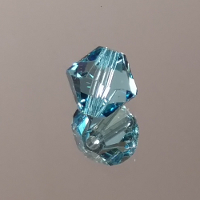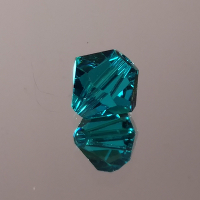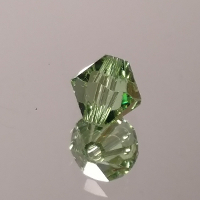This page offers a few little facts about the birthstone colors I use.
 January - Garnet
January - GarnetThe most common or traditional birthstone for January is the Garnet. While other birthstones have been used throughout the years, such as hyacinth, yellow or red Zircons, and Jasper, the Garnet has become the most common, and the most widely used. It has been known to represent constancy, truthfulness, purity, and sincerity, among other meanings.
While the garnet is most known for its deep red, often compared to the red of a pomegranate seed, it has also been seen in other colors - brighter reds, soft oranges, and has even been seen, very rarely, in green.
The garnet also has other properties, other than just being a lovely stone representing the month of January as a birthstone - it is also used in sand-paper grit often favored by fine wood-workers, and is also used in Healing-crystal arrays, associated with psychic protection, love, relationships, and earth-grounding.
The Swarovski Crystal Garnet, which I use in my creations, uses the most recognizable rich, deep red hue.
 February - Amethyst
February - AmethystThe most common or traditional of February's birthstones is the Amethyst. Like most birthstones, it is not the only one linked to the month of February. Other birthstones include hyacinth Zircon, Pearl, Onyx, and Moonstones. It has been known to represent stability, balance, courage, and peace.
Amethyst is a member of the Quartz family, its varying purple and violet hues likely the reason it is considered the most precious stone of the family.
The Amethyst has a bit of interesting history. Having been named the stone of sobriety, it was thought that to carry an Amethyst meant that one would not become drunk. It has also been worn by soldiers, believing it would keep them calm under stress.
Like most gems, the Amethyst also has a place in Healing-crystal arrays, associated with easing headaches and back-aches, as well as being a common focus crystal in raw crystal form.
The Swarovski Crystal Amethyst, which I use in my creations, represents a dark, rich hue; the most prized color average for the stone.
 March - Aquamarine
March - AquamarineThe most commonly recognized and traditional of March's birthstones is the Aquamarine. Like most other birthstones, it is not the only one that has been recognized. Other alternatives for the March birthstone are the Bloodstone, and occasionally Jasper.
Aquamarines are in the same family as the Emerald, the most commonly recognized May birthstone. Likely due to its soft blue-green color, it has been known through history as a sailor's good-luck charm, and was thought to a treasured stone to mermaids or sirens. It has been known to represent awareness and an aid to communication issues.
The Aquamarine also has its place in Healing-crystal arrays, particularly when used in conjunction to water, to heal heart, liver and stomach ailments, as well as throat issues and stress-related conditions.
The Swarovski Crystal Aquamarine, whch I use in my creations, represent the clear, light sea-blue that is the most recognizable color for fine quality Aquamarines.
 April - Diamond
April - DiamondThe most common and traditional birthstone for April is the Diamond. April is one of the few months that have many birthstones that have been recognized, including "other" birthstones, such as Sapphire, Topaz, Emerald and Opal. Other birthstones include Coral, Japser, Amber, Aventurine, and Turquoise.
April's birthstone has changed many times througout the years, and because of the Diamond's fame associated with engagement and marriage, can often be harder to purchase due to its demand, quality and often high price. Often, those born in April can be seen wearing some of April's other birthstones, often Opal or Turquoise.
The Diamond also has many other uses, much like the Garnet, it has been used in sand-papers meant for ultra fine work. It has also been used in files and drill-bits because of their hardness and lack of need for constant lubrication. It has also been used in sound recording, as the Diamond is harder than metal needles and will not wear down over time.
Even the Diamond has its place in Healing-crystal arrays, as a stone used to draw toxins from the body, a remedy for poisons, and also has been associated with healing brain-related diseases and gland disorders.
The Swarovski Crystal Clear, which I use in my creations, is the nearest one can get to the clear, fiery stone the Diamond can be.
 May - Emerald
May - EmeraldThe most commonly recognized birthstone for the month of May is the Emerald. Like April, May also has many birthstones that have been recognized for the month, such as Tiger's Eye, Citrine, Agate, Carnelian, Crysoprase, and Rose Quartz, in addition to Turqoise, Garnet, Amber, and the Pearl.
The Emerald is in the same family of stone as March's Aquamarine, but is most often seen in a rich green hue, though it has also been seen in shades of yellow, blue and even red. Emeralds that are lighter in color instead of its most recognizable rich, deep tones are more often given the name "green beryl".
Emeralds are known to represent clairevoyance and often are associated with memory, and also have their place in a Healing-crystal array to aid the eyes, the spine, and fertility. It has also been said to enhance mental or psychic capabilities.
The Swarovski Crystal Emerald, which I use in my creations, represents the rich, deep green the Emerald is most recognizable in.
 June - Pearl
June - PearlThe most commonly recognized birthstone for the month of June is the Pearl. Like April and May, June also has many birthstones to represent it. In addition to the Pearl, other recognized birthstones include the Moonstone, Alexandrite, Chalcedony, White Sapphire, Tiger's Eye, and Agate.
The Pearl itself is timeless, having been around since the birth of oysters! It has been known to represent loyalty and friendship, chastity and purity, which makes it a popular wedding adornment.
The Pearl also doesn't only come in "white". It can be found in a wide range of colors without the use of dyes, including cream, gold, green, blue and even rarely, black.
Pearls have also been ground into powder for medicines and for cosmetics. They have also been ingested whole and in powdered form for their flavor.
As nearly any other stone, the Pearl has its place in a Healing-crystal array, said to help the heart and also gastro-intestinal troubles such as ulcers.
The Swarovski Crystal Pearl, which I use in my creations, comes in a variety of colors. I use the classic White Pearl for my birthstone creations.
 July - Ruby
July - RubyThe most commonly recognized birthstone for the month of July is the Ruby. Like other months, it also has several other recognized birthstones, including the Onyx and the Sardonyx, the Tourmaline and the Carnelian.
The Ruby has been said to enhance vitality, strength, confidence and positive thinking, and has also been a symbol of royalty for its rich red color, which was associated with power or importance. In lore, it has been used to encourage prosperity, success and riches.
In addition to its use in jewelry and ornamentation, it has also been used in lasers, which is likely the reason that when one thinks of a laser, they think of the color red.
The Ruby, which shares parentage with the Sapphire, both in the Corundum family, is most typically admired as a rich red, but is often found in pink hues. Some of the most common Rubies are a red-violet or fuschia color.
As with other gems, it also has its place in a Healing-crystal array, often used to enhance blood flow, and to reduce or remove infection.
The Swarovski Crystal Ruby, which I use in my creations, represents the most common Ruby hue, which is not a pure red, but a slightly violet, or pink-red.
The most commonly recognized birthstone for the month of August is the Peridot. Like other months, August also has other recognizable birthstones, such as Alexandrite, Jade, Jasper and Zircon.
The Peridot, in the Olivine family, has also been known as Olivine, when its color is darker and more olive, or the gem is not fully crystalized. In cases where its color is lighter, or more yellow-green, it has been known as Chrysolite. The Peridot itself is most commonly a bright summer-green and has been called the "perfect summer-stone". It has also been found in brownish-green shades.
Like other stones, it is also used for more than its looks. Olivine stones have been used in sandblasting, and also in refractory sand and brick.
Some meanings for Peridot include fame, protection and dignity. It has been used in Egyptian royalty, possibly for these reasons, or for its use to enhance prosperity.
In a Healing-crystal array, Peridot has been used to aid ailments related to lungs and sinuses, as well as an aid in breast health.
The Swarovski Crystal Peridot, which I use in my creations, represents the bright summer-green the Peridot is most desired for.
 September - Sapphire
September - SapphireSeptember's most recognized birthstone is the Sapphire. As with other months, the Sapphire is not the only birthstone for September. Other birthstones include the Moonstone, Agate, Zircon, Sardonyx, Carnelian and Lapis Lazuli.
The Sapphire, which is in the same Corundum family as July's Ruby, is usually seen as a deep blue, but may also be found in other colors, such as white, colorless (clear, like a diamond), green, yellow, orange, pink, purple, black, and gray. The Pink Sapphire is one of the more common also seen in jewelry, often known as a Padparadsha.
The Sapphire is also more than just an admired trinket. It is used in some window creation, and also in lasers. Sapphire "glass" windows are used in Blu-Ray players, grocery store barcode scanners, and Sapphire crystals are used in some watches. It is also used as an insulator in high powered circuitry in computers. It also finds itself in the military, in shatter-resistant windows on armored vehicles, and even in body armor!
The Sapphire is said to represent sincerity and constancy, and also peace of mind.
As with other gems, the Sapphire also has its part to play in Healing-crystal arrays, aiding in lowering fevers and inflammation, lessening hearing issue, and soothing burns. It has also been said that Sapphires may be an aid in reducing cancers.
The Swarovski Crystal Sapphire, which I use in my creations, respresents the clear, pure blue that Sapphires are known best for.
 October - Opal
October - OpalOctober's traditional and most common birthstone is the Opal - though more often you will see Pink Tourmaline in its place due to the Opal's softer stone property and often high price for a good quality stone. These two are also joined by Jasper, Coral and Beryl.
Opals are a very odd stone, probably because they're not actually a stone at all! Opals are hardened silica gel, not crystaline, like other gemstones. The high amount of water content (up to 20%) gives it its delicate nature, as it can crack or mar easily when moving in and out of widely varying temperatures (stepping out into the snow from a heated home, for instance, could crack or mar an Opal). Instead of being a clear and brilliant color, Opals can be several different shades - the most common of which is the "White Opal". White Opals are a white-milky color, opaque or translucent. The color comes from the tiny crystals and odd lines of the hardened silica spheres refracting light, giving it the appearance of having a rainbow of color, much like the "rainbow lines" of a quartz crystal or prism (and as some have said, looking like someone poured coarse glitter into resin).
Opals come in many colors, which include Fire Opal, Black Opal, White Opal, Peruvian Opal and many many more varieties. The most commonly seen is the White Opal.
Opals have many properties, representing hope, innocence, happiness, faithfulness, loyalty and purity, even though it was once a bad luck omen, likely due to a book Sir Walter Scott wrote. However, it has also been a good luck omen, which seems to have won out.
Like most other gems, the Opal does have a place in Healing-crystal arrays, though not as a direct healer. The Opal's properties are turned more towards enhancing the imagination, dreams and visualization, though has been known to be an enhancer for other healing stones, and also has a history of supposedly aiding with eye infection.
Swarovski Crystals have many colors of opal available, though for the October birthstone, I use the traditional White Opal color, which is a milky white and looks plain until struck by halogen shade or sunlight, where the color beneath shines through in green, red and amber brilliance. (Because of its odd configuration, it is the most difficult for me to photograph.)
 November - Topaz
November - TopazNovember only has a few birthstones to represent it, the most common and traditional of which is the Yellow Topaz. Other birthstones include the Citrine (also yellow in color), the Yellow Sapphire, Yellow Beryl, Pearl, Turquoise and Chrysoprase.
The Topaz can be found in many colors, and all have been used to represent November as its birthstone, though the most recognized color is a rich golden color that is not fully yellow, but yet not orange either. This color is the most prized of the Topaz colors, though it can be found in yellow, orange, reddish brown, blues, pinks, light green, and even violet colors. In fact, the Blue Topaz is often used as the December birthstone in jewelry when Blue Zircon is not available or vice-versa.
The color we think of when we think of Topaz (the rich, gold color) has a place in some of the Topaz lore. Egyptians believed its rich golden color was a gift from the Sun God, Ra. It was used in adornments, most commonly amulets, to protect followers from danger and harm. The Egyptians were not the only ones to think of the sun when dealing with Topaz, either - Romans also believed the Topaz to be a gift from the God of the Sun, Jupiter.
The Topaz has many properties, like all stones. It is associated with friendship, loyalty and faithfulness, as well as raising spiritual awareness, likely trickling down from similar ideas as the Egyptians and Romans.
It also has a place like most stones in a Healing-crystal array, promoting sanity as well as aiding with blood disorders, gout, and insomnia.
The Swarovski Crystal Topaz, which I use in my creations, represents the rich reddish-gold color that is most sought after in this gem.
 December - Blue Zircon
December - Blue ZirconThe December birthstone is one of the few that is under a constant shift. It shares several stones who claim the right to represent December, the two most common being Turquoise and Blue Zircon. Other stones that may represent the month are the Lapis and Onyx. I use the Blue Zircon.
The Zircon, much like the Topaz, comes in many different colors, many of them very similar: browns, yellows, oranges, reds, greens, blues, pinks, and violets. In fact, very often a Blue Topaz will be used interchangably with the Blue Zircon in jewelry. The Blue Zircon is more often found in lighter blues that may be easily confused with the Aquamarine, but rarely can be found in a brilliant brighter greenish-blue.
The Zircon is quite heavy, and when weighed, the cut will often be smaller than other stones of the same weight. Much like the Diamond, it is very hard and if faceted, may chip a bit more readily than some other stones. The Zircon is also commonly mistaken as Cubic Zirconia, which is a synthetic Diamond. Unlike Cubic Zirconia, the Zircon is found in nature.
One thing of note is that Blue Zircons are often man-made - that is to say a Zircon that is paler or colorless is given its blue color by irradiation with gamma rays. Because of this, some of the darker or deeper blues that have been made this way may be radioactive! When this stone is purchased from somewhere other than the United States, it must be tested for its levels of radioactivity. More often than not, the levels are negligible or far too low to cause danger.
The Blue Zircon (natural, not irradiated) has been reputed to balance and stabilize emotion, promote common sense and aid those who wear it overcome losses and mental troubles. As most gems, it has its place in a Healing-crystal array, aiding in respitory issues such as asthma, colds and bronchitis, as well as soothing liver and gall bladder troubles.
The Swarovski Crystal Blue Zircon, which I use in my creations, represents the deep greenish-blue that is least common, and is such a rich color that it cannot be confused with the Aquamarine that represents March.
